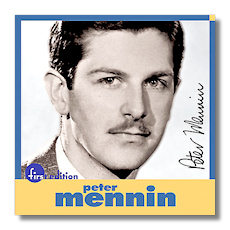
The Internet's Premier Classical Music Source
Related Links
- Mennin Reviews
- Latest Reviews
- More Reviews
-
By Composer
-
Collections
DVD & Blu-ray
Books
Concert Reviews
Articles/Interviews
Software
Audio
Search Amazon
Recommended Links
Site News
 CD Review
CD Review
Peter Mennin

Louisville premières
- Symphony #5 (1950)
- Concerto for Cello & Orchestra (1956) *
- Symphony #6 (1953)
* János Starker, cello
* The Louisville Orchestra/Jorge Mester
The Louisville Orchestra/Robert Whitney
First Edition Music FECD-0013 (^Mono) 65:54
Summary for the Busy Executive: More recording premières from the Louisville Orchestra archives, the repository of one of the most ambitious recording projects of Modern American music.
At one time, many regarded Peter Mennin (1923-83) as the most promising of younger American symphonists. Prestigious organizations commissioned him. Writers undertaking surveys of the modern symphony said nice things about him. Unfortunately he came to prominence in the Forties and Fifties. He rose quickly, in fact just out of school, taught composition at Juilliard and Peabody, and wound up head of Juilliard. Unfortunately, Mennin's work came at the end of the era of the heroic American symphony, and he continued to write. The title of Young Man of Promise it turns out wasn't worth having: after a certain point, few who mattered cared about his kind of symphony. Furthermore, his administrative duties seriously cut into his composing time, so that not only did he write very little from the Sixties to his death in 1983, but the late music isn't very well known.
Despite study with the American Stravinskian Normand Lockwood and with Hanson and Rogers at Eastman in the Forties, Mennin largely taught himself. He wrote his first symphony in 1942 at the age of 19. His slow music is characterized by long lines and bristly dissonance; his fast, by a bubbling, vigorously rhythmic counterpoint.
Mennin had completed five of his nine symphonies by the age of 27, and the first five are more or less of a piece. Written for the Dallas Symphony and premièred on LP by the Louisville, the Fifth Symphony falls into three movements – fast, slow, fast. All three movements show roughly the same procedure. Mennin doesn't rely on sonata form but prefers to follow an "organic" line of argument. This does not mean, however, that the movements go slack in any way. Indeed, they tersely and compactly spin a line of steel. There are few "themes" as such. Mennin takes an arresting musical gesture, and from that flowers different ideas. It's like watching a good mix-em-up pitcher going into the same windup and releasing something different every time. The counterpoint, dense and fierce, I believe shows the influence of the fast sections of Vaughan Williams' Fourth Symphony, without the curse of imitation, and indeed has much of that same power to compel.
The concerto and the Sixth Symphony work a bit differently and act as paths toward Mennin's final style – less ingratiating, darker, more complex. In the liner notes, Frank J. Oteri compares this concerto to recent ones by Elliott Carter, and I can see his point, despite the dissimilarity of idiom. Mennin's concerto embraces both virtuosity and symphonic argument, but to me it misses something as a concerto. Mennin's style is so contrapuntal – so many lines busily scurry about – that the soloist becomes just one more line, perhaps first among equals, but not sharply distinguished from the mass. That aside, the concerto excites me as music, in Mennin's usual way of vigorous rhythm and full brass. My favorite movement is the slow movement, not coincidentally the one which makes the best use of the soloist. Normally, the fast rather than the slow attracts me, but the music, grave and beautiful, takes a risk which pays off – essentially varying throughout one idea, which all by itself gets inside you. The shaping of the movement, an emotional arch, shows the hand of a master. The finale, similar to a rondo, takes a typical Mennin fanfare (based on an idea in the first movement, incidentally) and a toccata idea through their paces and builds to a conclusion that leaves you breathless (once you leap to your feet, of course).
Variation rather than sonata drew Mennin, and we see in his music at this point the increasing adaptation of continual variation, which culminates in his Seventh Symphony (1963). But it already peeks out in his Sixth Symphony ten years earlier. Commissioned by Louisville, it's already denser than the Fifth. Indeed, it brims so full of independent lines that the composer doesn't always escape the charge of thickness. It follows its predecessor's pattern of fast-slow-fast, but it differs significantly in the way Mennin generates themes. Instead of the windup-release, Mennin essentially gives us just the release and keeps working changes on it. Different movements get different starting points, however. He doesn't take it quite so far as the Seventh, where one idea forms the basis of the entire symphony. One also finds in the Sixth the same galvanic rhythmic spark that characterizes the Fifth. I like the finale the best. It presents ideas from the previous movements in new contexts without indulging in cyclic construction. The counterpoint dazzles so, you may miss them anyway, as they beetle beneath and in-between the orchestral fabric.
Almost all these works come in versions with better sound: David Miller on Albany TROY260 leading an all-Mennin program. You get the bonus of the early Fantasia for String Orchestra, but you miss the cello concerto with Starker – I believe the only commercial recording ever of this piece. Furthermore, Starker always breathed the air of legend, and I consider this one of his finest performances. It is, thank goodness, stereo. Nevertheless, in the symphonies, the mono sound from Louisville is boxy and dull. It's your call.
Copyright © 2008, Steve Schwartz




















